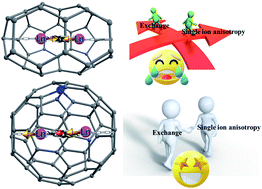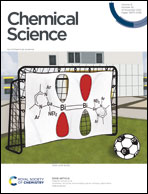Attaining record-high magnetic exchange, magnetic anisotropy and blocking barriers in dilanthanofullerenes†
Abstract
While the blocking barrier (Ueff) and blocking temperature (TB) for “Dysprocenium” SIMs have been increased beyond liquid N2 temperature, device fabrication of these molecules remains a challenge as low-coordinate Ln3+ complexes are very unstable. Encapsulating the lanthanide ion inside a cage such as a fullerene (called endohedral metallofullerene or EMF) opens up a new avenue leading to several Ln@EMF SMMs. The ab initio CASSCF calculations play a pivotal role in identifying target metal ions and suitable cages in this area. Encouraged by our earlier prediction on Ln2@C79N, which was verified by experiments, here we have undertaken a search to enhance the exchange coupling in this class of molecules beyond the highest reported value. Using DFT and ab initio calculations, we have studied a series of Gd2@C2n (30 ≤ 2n ≤ 80), where an antiferromagnetic JGd⋯Gd of −43 cm−1 was found for a stable Gd2@C38-D3h cage. This extremely large and exceptionally rare 4f⋯4f interaction results from a direct overlap of 4f orbitals due to the confinement effect. In larger cages such as Gd2@C60 and Gd2@C80, the formation of two centre-one-electron (2c-1e−) Gd–Gd bonds is perceived. This results in a radical formation in the fullerene cage leading to its instability. To avoid this, we have studied heterofullerenes where one of the carbon atoms is replaced by a nitrogen atom. Specifically, we have studied Ln2@C59N and Ln2@C79N, where strong delocalisation of the electron yields a mixed valence-like behaviour. This suggests a double-exchange (B) is operational, and CASSCF calculations yield a B value of 434.8 cm−1 and resultant JGd–rad of 869.5 cm−1 for the Gd2@C59N complex. These parameters are found to be two times larger than the world-record J reported for Gd2@C79N. Further ab initio calculations reveal an unprecedented Ucal of 1183 and 1501 cm−1 for Dy2@C59N and Tb2@C59N, respectively. Thus, this study offers strong exchange coupling as criteria for new generation SMMs as the existing idea of enhancing the blocking barrier via crystal field modulation has reached its saturation point.



 Please wait while we load your content...
Please wait while we load your content...